Superregnum: Eukaryota
Cladus: Unikonta
Cladus: Opisthokonta
Cladus: Holozoa
Regnum: Animalia
Subregnum: Eumetazoa
Cladus: Bilateria
Cladus: Nephrozoa
Superphylum: Deuterostomia
Phylum: Chordata
Subphylum: Vertebrata
Infraphylum: Gnathostomata
Megaclassis: Osteichthyes
Cladus: Sarcopterygii
Cladus: Rhipidistia
Cladus: Tetrapodomorpha
Cladus: Eotetrapodiformes
Cladus: Elpistostegalia
Superclassis: Tetrapoda
Cladus: Reptiliomorpha
Cladus: Amniota
Classis: Reptilia
Cladus: Eureptilia
Cladus: Romeriida
Subclassis: Diapsida
Cladus: Sauria
Infraclassis: Archosauromorpha
Cladus: Crurotarsi
Divisio: Archosauria
Cladus: Avemetatarsalia
Cladus: Ornithodira
Subtaxon: Dinosauromorpha
Cladus: Dinosauriformes
Cladus: Dracohors
Cladus: Dinosauria
Ordo: Saurischia
Cladus: Eusaurischia
Subordo: Theropoda
Cladus: Neotheropoda
Cladus: Averostra
Cladus: Tetanurae
Cladus: Avetheropoda
Cladus: Coelurosauria
Cladus: Tyrannoraptora
Cladus: Maniraptoromorpha
Cladus: Maniraptoriformes
Cladus: Maniraptora
Cladus: Pennaraptora
Cladus: Paraves
Cladus: Eumaniraptora
Cladus: Avialae
Infraclassis: Aves
Cladus: Avebrevicauda
Cladus: Pygostylia
Cladus: Ornithothoraces
Cladus: Ornithuromorpha
Cladus: Carinatae
Parvclassis: Neornithes
Cohors: Neognathae
Cladus: Neoaves
Cladus: Telluraves
Cladus: Australaves
Ordo: Passeriformes
Subordo: Tyranni
Infraordo: Tyrannides
Parvordo: Tyrannida
Familia: Tityridae
Genus: Pachyramphus
Species: P. aglaiae – P. albogriseus – P. castaneus – P. cinnamomeus – P. homochrous – P. major – P. marginatus – P. minor – P. niger – P. polychopterus – P. rufus – P. salvini – P. spodiurus – P. surinamus – P. validus – P. versicolor – P. viridis – P. xanthogenys
Name
Pachyramphus Gould & Gray, 1839
Typus: Psaris cuvieri Swainson, 1821 syn. Tityra viridis Vieillot, 1816 = Pachyramphus viridis
Synonyms
Pachyrhynchus Spix, 1825 Av.Sp.Nov.Brasil. p. 31 BHL
Bathmidurus Cabanis, 1847 Arch.Naturgesch p. 243 BHL
Platypsaris P.L. Sclater, 1857 PZS p. 72 BHL
Chloropsaris Kaup, 1852 PZS p. 45 BHL
Callopsaris Bonaparte, 1854 Ann.Sci.Nat., Zool. p. 134 BHL
Hadrostomus Cabanis & Heine, Sr, 1859 Mus.Hein. p. 84 BHL
Zetetes Cabanis & Heine, Sr, 1859 Mus.Hein. p. 87 BHL
Berlepschia W. Bertoni, 1901 Av.Nuev.Paraguay p. 114 BHL
Climacocercus W. Bertoni, 1901 Av.Nuev.Paraguay p. 112 BHL
Pachyrhamphus [variation]
References
Primary references
Gray, G.R. 1840. A list of the genera of birds, with an indication of the typical species of each genus, compiled from various sources. 80 pp. Richard and John Taylor (London). p. 31 BHL DOI: 10.5962/bhl.title.13777 Reference page.
Gould, J. 1839. Part 3 Birds. In: The Zoology of the voyage of H.M.S. Beagle, under the command of Captain Fitzroy, R.N., during the years 1832-1836. Edited and superintended by Charles Darwin. Smith, Elder & Co. London. 1841. 156 pp., 50 tt. DOI: 10.5962/bhl.title.14216 BHL Reference page. no.6 pl. 14
Additional references
Musher, L.J. & Cracraft, J. 2018. Phylogenomics and species delimitation of a complex radiation of Neotropical suboscine birds (Pachyramphus). Molecular Phylogenetics and Evolution 118: 204–221. DOI: 10.1016/j.ympev.2017.09.013 Open access Reference page.
Musher, L.J., Krabbe, N.K. & Areta, J.I. 2023. Underestimated Neotropical diversity: Integrative taxonomy reveals two unrelated look-alike species in a suboscine bird (Pachyramphus albogriseus). Ornithology 140: 1–17. DOI: 10.1093/ornithology/ukac047 Open access Reference page.
Vernacular names
English: Becards
español: Anambés
português: Caneleiros
A becard is a bird of the genus Pachyramphus in the family Tityridae.
Taxonomy
The genus Pachyramphus was introduced in 1839 by the English zoologist George Robert Gray in the volume on birds by John Gould that formed part of Charles Darwin's Zoology of the Voyage of H.M.S. Beagle.[2][3][4] The type species was designated by Gray in 1840 as the green-backed becard (Pachyramphus viridis).[5] The generic name is from the Ancient Greek pakhus meaning "stout" or "thick" and rhamphos meaning "bill".[6]
The genus had traditionally been placed in Cotingidae or Tyrannidae, but evidence strongly suggests that it is better placed in the family Tityridae, where it is now placed by the IOC.[7]
Extant species
The genus contains eighteen species:[8]
| Image | Scientific name | Common Name | Distribution |
|---|---|---|---|
 |
Pachyramphus viridis | Green-backed becard | Argentina, Bolivia, Brazil, Guyana, Paraguay, Uruguay, and Venezuela. |
 |
Pachyramphus xanthogenys | Yellow-cheeked becard | south Colombia, east Ecuador, central Peru |
 |
Pachyramphus versicolor | Barred becard | from Costa Rica to northwestern Ecuador and northern Bolivia. |
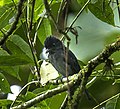 |
Pachyramphus spodiurus | Slaty becard | Ecuador and far northern Peru. |
 |
Pachyramphus rufus | Cinereous becard | Brazil, Colombia, Ecuador, French Guiana, Guyana, Panama, Peru, Suriname, and Venezuela |
 |
Pachyramphus castaneus | Chestnut-crowned becard | Brazil, Colombia, Peru, Ecuador, and Bolivia and regions of Venezuela |
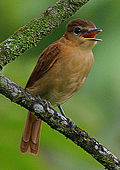 |
Pachyramphus cinnamomeus | Cinnamon becard | south-eastern Mexico south to north-western Ecuador and north-western Venezuela |
 |
Pachyramphus polychopterus | White-winged becard | Argentina, Belize, Bolivia, Brazil, Colombia, Costa Rica, Ecuador, French Guiana, Guatemala, Guyana, Honduras, Mexico, Nicaragua, Panama, Paraguay, Peru, Suriname, Trinidad and Tobago, Uruguay, and Venezuela. |
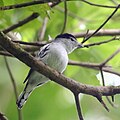 |
Pachyramphus marginatus | Black-capped becard | Bolivia, Brazil, Colombia, Ecuador, French Guiana, Guyana, Peru, Suriname, and Venezuela. |
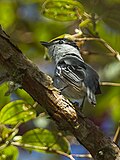 |
Pachyramphus albogriseus | Black-and-white becard | Colombia, Costa Rica, Ecuador, Guatemala, Nicaragua, Panama, and Venezuela. |
| Pachyramphus salvini | Cryptic becard | Ecuador and Peru. | |
 |
Pachyramphus major | Grey-collared becard | Belize, El Salvador, Guatemala, Honduras, Mexico, and Nicaragua. |
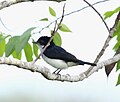 |
Pachyramphus surinamus | Glossy-backed becard | Brazil, French Guiana, and Suriname. |
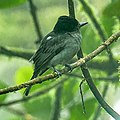 |
Pachyramphus homochrous | One-colored becard | Colombia, Ecuador, Panama, Peru, and Venezuela. |
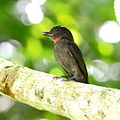 |
Pachyramphus minor | Pink-throated becard | Bolivia, Brazil, Colombia, Ecuador, French Guiana, Guyana, Peru, Suriname, and Venezuela. |
 |
Pachyramphus validus | Crested becard | Argentina, Bolivia, Brazil, Ecuador, Paraguay, and Peru. |
 |
Pachyramphus aglaiae | Rose-throated becard | south-easternmost Arizona and extreme southern Texas of the United States to western Panama. |
 |
Pachyramphus niger | Jamaican becard | Jamaica. |
Former species
Some authorities, either presently or formerly, recognize several additional species as belonging to the genus Pachyramphus including:
Rusty-vented canastero (as Bathmidura Dorbignyi)[9]
Description
The becards are characterized by their large heads with a slight crest.[10] The smaller members of this genus have graduated tails and most members are sexually dimorphic, although the cinnamon becard[10] and the chestnut-crowned becard have similar plumages for the males and females. Juvenile becards resemble the adult females in plumage and, as far as known, obtain their adult plumage after about a year.[10] The bills of the becards are grey, and many (but not all) have a black culmen or upper mandible. Their legs are dark gray.[10]
Distribution and habitat
They are primarily found in Central and South America, but the rose-throated becard occurs as far north as southern United States and, as suggested by its common name, the Jamaican becard is restricted to Jamaica.[11] Depending on the species, they are found in wooded habitats ranging from open woodland to the dense canopy of rainforests.
Breeding
The nest of a becard is a bulky globular mass of dead leaves, mosses, and fibers with the entrance near the bottom of the nest.[10] Nests are typically wedged or slung from the outer branches of trees at the mid or upper levels.[10]
References
"Tityridae". aviansystematics.org. The Trust for Avian Systematics. Retrieved 2023-07-24.
Gray G.R. in Gould, John (1841). Darwin, Charles (ed.). The Zoology of the Voyage of H.M.S. Beagle, Part III. Birds. London: Smith, Elder and Company. p. 50. Although the title page bears a date of 1841, both the plates and the text on Pachyramphus were issued in 1839.
Steinheimer, F.; Dickinson, E.C.; Walters, M.P. (2006). "The Zoology of the Voyage of H.M.S. Beagle, Part III. Birds. New avian names, their authorship and the dates". Bulletin of the British Ornithologists' Club. 126 (2): 171–193 [177].
International Code of Zoological Nomenclature (2010). "Opinion 2263 (Case 3466) Pachyramphus G.R. Gray in Gould, 1839 (July) (Aves, Passeriformes, Cotingidae): generic name conserved". Bulletin of Zoological Nomenclature. 67 (4): 346–347. doi:10.21805/bzn.v67i4.a16.
Gray, George Robert (1840). A List of the Genera of Birds : with an Indication of the Typical Species of Each Genus. London: R. and J.E. Taylor. p. 31.
Jobling, James A. (2010). The Helm Dictionary of Scientific Bird Names. London: Christopher Helm. p. 288. ISBN 978-1-4081-2501-4.
Adopt the Family Tityridae Archived 2008-05-08 at the Wayback Machine – South American Classification Committee (2007)
Gill, Frank; Donsker, David, eds. (2019). "Cotingas, manakins, tityras, becards". World Bird List Version 9.2. International Ornithologists' Union. Retrieved 18 August 2019.
"Asthenes dorbignyi - Avibase". avibase.bsc-eoc.org. Retrieved 2017-04-15.
Howell, Steve N.G.; Webb, Sophie (1995), A Guide to the Birds of Mexico and Northern Central America, New York: Oxford University Press, pp. 520, ISBN 0-19-854012-4
Miller, Eliot T.; Wagner, Sarah K.; Klavins, Juan; Brush, Timothy; Greeney, Harold F. (16 March 2015). "Striking Courtship Displays in the Becard Clade Platypsaris". The Wilson Journal of Ornithology. 127 (1): 123–126. doi:10.1676/14-030.1.
Retrieved from "http://en.wikipedia.org/"
All text is available under the terms of the GNU Free Documentation License

